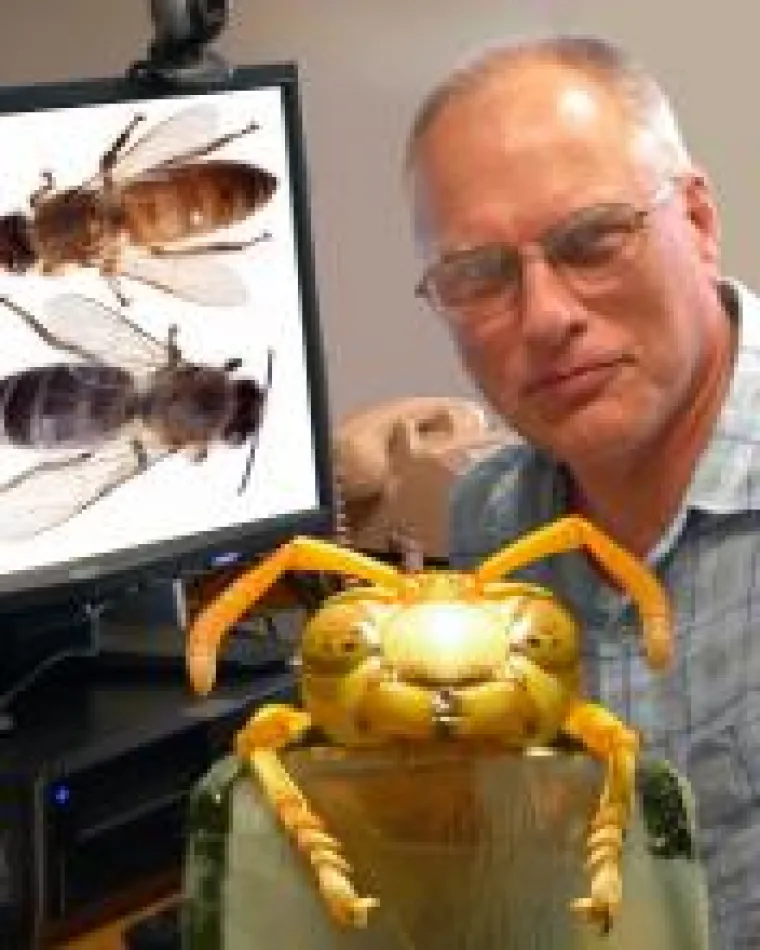Wulfila Gronenberg, Ph.D.

Rm 422 Gould-Simpson
Neuronal control of complex behavior; multimodal information processing and brain plasticity
We are interested in the neuronal control of behavior at different levels of behavioral complexity. In our lab, we favor the comparative approach towards neuroethology, focusing on the brain and behavior of Hymenoptera (bees, ants, and wasps) and some arachnids (spiders and their kin).
Insects
Some Hymenoptera have evolved social lifestyles (e.g. honey bees, paper wasps, ants). Individual social insects often show sophisticated behaviors (e.g. communication, navigation, etc.) and pronounced learning and memory capabilities and we are interested in the neural basis of such behavioral feats (e.g. color and odor learning).
Brain and behavior. Most insects rely on olfaction and tactile cues for communication and orientation. Wasps and bees, and some ants use their keen sight to navigate by visual landmarks, to find flowers, nests, or mating points, to catch prey and even for individual 'face' recognition (some paper wasps). By comparing the brains of insects that rely on different sensory cues and show pronounced differences in behavior, we try to get insights into the function of particular brain structures. The brains of Hymenoptera comprise prominent odor-processing centers (antennal lobes) and large visual centers (bees and wasps, some ants). Central brain structures such as the so-called mushroom bodies process multimodal information and are involved in orientation, decision-making, learning and memory.
Brain and brain component size and activity. For a long time people have been intrigued by correlations between animals’ brain or brain component size or brain organization and behavioral capacities. We compare brain and brain component size and metabolic brain activity across species and castes, and we ask what the behavioral advantages of larger or more active brains or brain components are, keeping in mind that even tiny insects with minuscule brains are doing just fine in their respective environments.
Brain size and neuron number. Tiny insects not only have tiny brains, but there neurons also are smaller. We compare the number of brain cells in different Hymenoptera, covering a large range of body and brain sizes from tiny parasitoid wasps smaller than fruit flies to large carpenter bees and ‘tarantula hawk’ wasps, and we also compare the brains of solitary and social wasps, bees and ants. Smaller insects pack more neurons into their smaller brains while social insects do not seem to have more ‘advanced’ brains than their solitary relatives.
The mushroom bodies are particularly large in behaviorally advanced hymenopteran species, suggesting a correlation with their rich behavioral repertoires. We analyze the brains and nerve cells of different species and castes to quantify differences in their brain design. These data are compared to the behavioral performance of the respective species in quantitative laboratory tests and learning paradigms in particular.
Arachnids
Compared to insects, very little is known about the nervous systems of spiders and their kin. Arachnids are very sensitive to mechanical stimuli (touch, vibration, wind, etc.) and some have very acute vision (e.g. jumping spiders) whereas others do not. While our knowledge about chemical senses in spiders is severely lacking, it is known that spiders, scorpions and other arachnid orders have chemoreceptors on their legs, feelers or specialized organs. Next to nothing is known about where in their brains this chemical information is processed, and we are trying to find out. We found structures indicative of olfactory information processing (glomeruli) in the central nervous systems of spiders and harvestmen and in the exceedingly large mushroom bodies of whip spiders. The latter are of particular interest as whip spiders reportedly navigate using their sense of smell, and their brain may comprise chemical ‘maps’ which, we think, may reside in their large mushroom bodies. In addition to olfactory information, these mushroom bodies also receive visual input.
Selected Recent Publications
Godfrey RK, Swartzlander M, Gronenberg W (2021) Allometric analysis of brain cell number in Hymenoptera suggests ant brains diverge from general trends. Proc. R. Soc. B 288: 20210199. https://doi.org/10.1098/rspb.2021.0199
Riveros AJ, Leonard AS, Gronenberg W, Papaj DR (2020) Learning of bimodal versus unimodal signals in restrained bumble bees. J Exp Biol 223: jeb220103 doi: 10.1242/jeb.220103
Godfrey RK, Gronenberg W (2019) Linking Colony Size with Foraging Behavior and Brain Investment in Odorous Ants (Formicidae: Dolichoderinae). Brain Behav Evol DOI: 10.1159/000504643
Godfrey RK, Gronenberg W (2019) Brain evolution in social insects: advocating for the comparative approach. J. Comp. Physiol. A; https://doi.org/10.1007/s00359-019-01315-7
Leitner N, Charbonneau D, Gronenberg W, Dornhaus A( 2018) Peripheral sensory organs vary among ant workers but variation does not predict division of labor. Behav. Processes. 158:137-143. doi: 10.1016/j.beproc.2018.10.016
Larabee FJ, Gronenberg W, Suarez A (2017)Performance, Morphology, and Control of Power-amplified Mandibles in the Trap-jaw Ant, Myrmoteras (Hymenoptera: Formicidae). J. Exp. Biol.220(Pt 17): 3062-3071. doi: 10.1242/jeb.156513.
Wiegmann DD, Hebets EA, Gronenberg W, Graving JM, Bingman VP (2016) Amblypygids: Model Organisms for the Study of Arthropod Navigation Mechanisms in Complex Environments? Front. Behav. Neurosci. 10:47.doi: 10.3389/fnbeh.2016.00047
Amador-Vargas S, Gronenberg W, Wcislo W, Mueller U (2015) Specialization and group size: brain and behavioral correlates of colony size in ants lacking morphological castes. Proc R Soc B DOI: 10.1098/rspb.2014.2502
Muscedere ML, Gronenberg W, Moreau CS, Traniello JFA (2014) Investment in higher-order central processing regions is not constrained by brain size in social insects. Proc. R. Soc. B 281: 20140217. https://dx.doi.org/10.1098/rspb.2014.0217
Gronenberg W, Raikhelkar A, Abshire E, Stevens J, Epstein E, Loyola K, Rauscher M, Buchmann S (2014) Honey bees (Apis mellifera) learn to discriminate the smell of organic compounds from their respective deuterated isotopomers. Proc. R. Soc. B 20133089. https://dx.doi.org/10.1098/rspb.2013.3089
Jones MB, Leonard AS, Papaj DR, Gronenberg W (2013) Plasticity of the worker bumblebee brain in relation to age and rearing environment. Brain Behav. Evol. 82:250-261 (DOI: 10.1159/000355845)
Milton Giraldo Y, Patel E, Gronenberg W, Traniello JFA(2013) Division of labor and structural plasticity in a serotonergic extrinsic mushroom body neuron in the ant Pheidole dentate. Neurosci Letters 534: 107– 111

